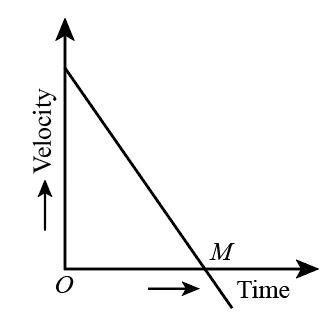
In Fig.

A. retardation is uniform
B. velocity is decreasing with time
C. beyond M, the body has negative velocity
D. all the above statements are correct.

Answer
491.1k+ views
1 likes
Hint: We know that the change of velocity with time gives us the value of acceleration and when the curve of the velocity-time graph gives us the magnitude and nature of the acceleration that is whether it is negative or positive. We will use this concept to find the most suitable answer for our problem.
Complete step by step answer:From the given graph, we can see that the curve is negative, that means the velocity is decreasing as time progresses. Hence, option (B) is correct.
We also know that the value of velocity given by the straight line above the time axis is positive and it becomes zero at point M. Beyond point M, it becomes negative so we can say that velocity of the given body beyond point M is negative.
Hence option (C) is correct.
As we know that the acceleration is given by the curve of the velocity-time graph and the slope of the graph is negative. The slope of the velocity-time graph is given a straight line which means that the change of velocity with respect to time is constant. In other words, we can say that velocity change with time is constant, so the acceleration is uniform. Hence, option (A) is correct.
Therefore, from the above explanation, we can say that all the above statements are correct, and option (D) is correct.
Note:We know that the velocity is decreasing with time, so the acceleration is negative and called negative acceleration or retardation. Velocity becomes negative beyond point M, but acceleration is negative from the start, even at the point where velocity is positive.
Complete step by step answer:From the given graph, we can see that the curve is negative, that means the velocity is decreasing as time progresses. Hence, option (B) is correct.
We also know that the value of velocity given by the straight line above the time axis is positive and it becomes zero at point M. Beyond point M, it becomes negative so we can say that velocity of the given body beyond point M is negative.
Hence option (C) is correct.
As we know that the acceleration is given by the curve of the velocity-time graph and the slope of the graph is negative. The slope of the velocity-time graph is given a straight line which means that the change of velocity with respect to time is constant. In other words, we can say that velocity change with time is constant, so the acceleration is uniform. Hence, option (A) is correct.
Therefore, from the above explanation, we can say that all the above statements are correct, and option (D) is correct.
Note:We know that the velocity is decreasing with time, so the acceleration is negative and called negative acceleration or retardation. Velocity becomes negative beyond point M, but acceleration is negative from the start, even at the point where velocity is positive.
Recently Updated Pages
Master Class 11 Economics: Engaging Questions & Answers for Success

Master Class 11 Business Studies: Engaging Questions & Answers for Success

Master Class 11 Accountancy: Engaging Questions & Answers for Success

Master Class 11 English: Engaging Questions & Answers for Success

Master Class 11 Computer Science: Engaging Questions & Answers for Success

Master Class 11 Maths: Engaging Questions & Answers for Success

Trending doubts
State and prove Bernoullis theorem class 11 physics CBSE

1 ton equals to A 100 kg B 1000 kg C 10 kg D 10000 class 11 physics CBSE

State the laws of reflection of light

One Metric ton is equal to kg A 10000 B 1000 C 100 class 11 physics CBSE

Difference Between Prokaryotic Cells and Eukaryotic Cells

1 Quintal is equal to a 110 kg b 10 kg c 100kg d 1000 class 11 physics CBSE




